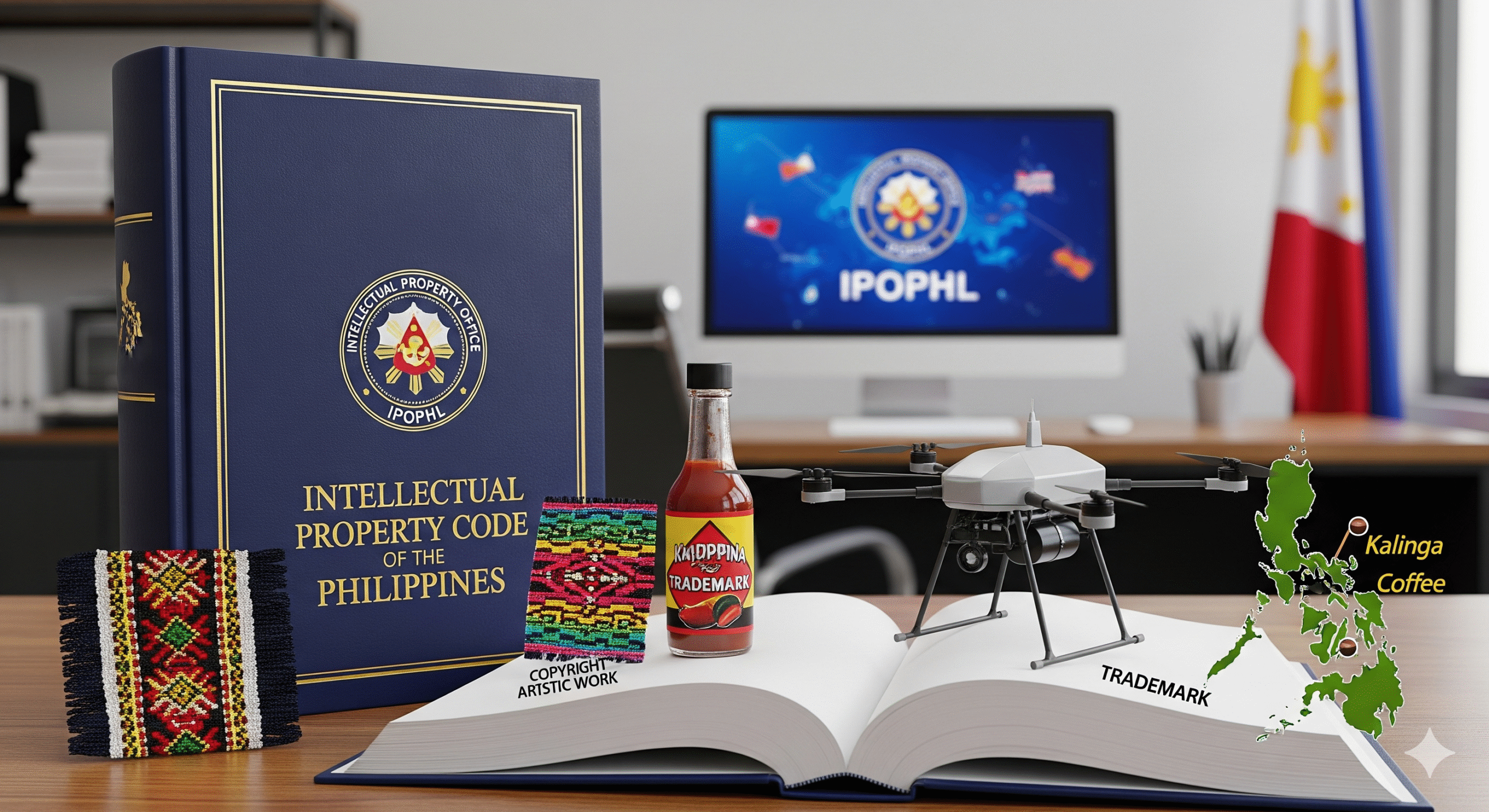Since innovation and creativity are what drive the economy in the modern era, protecting intellectual property (IP) is significant to a nation’s success. Filipino entrepreneurs, artists, inventors, and businesses must be aware of the laws safeguarding intellectual property rights to protect their creations and use them to their advantage in the marketplace. Based on relevant laws and court decisions, this article may provide a brief overview of intellectual property law in the Philippines, emphasizing how to safeguard novel concepts and trademarks.
The Legal Framework of Intellectual Property in the Philippines
The Intellectual Property Code
Republic Act No. 8293, also called the “Intellectual Property Code of the Philippines,” is the main law in the Philippines that protects intellectual property and its proprietary rights. This law set up the Intellectual Property Office of the Philippines (IPOPHL) and made it easier to protect several types of intellectual property, such as patents, trademarks, and copyrights.
“This Act shall be known as the ‘Intellectual Property Code of the Philippines.’ … The State recognizes that an effective intellectual and industrial property system is vital to the development of domestic and creative activity, facilitates transfer of technology, attracts foreign investments, and ensures market access for our products. It shall protect and secure the exclusive rights of scientists, inventors, artists, and other gifted citizens to their intellectual property and creations, particularly when beneficial to the people, for such periods as provided in this Act.”1
Recent Developments: The Philippine Innovation Act
The legal landscape has evolved with the passage of Republic Act No. 11293, or the “Philippine Innovation Act”2, which emphasizes innovation as a driver of inclusive development and national competitiveness. The Act, along with its rules for implementation, highlights how important protecting intellectual property is for encouraging innovation, especially for small businesses.
What is Intellectual Property
Intellectual property is the term for things that are made up of ideas, like inventions, books, paintings, drawings, symbols, names, and pictures utilized in business. The law recognizes different types of IP, and each type has its own rights and protections:
- Patents: Protect inventions that are new, involve an inventive step, and are industrially applicable.
- Trademarks: Protect signs capable of distinguishing the goods or services of one enterprise from those of others.
- Copyrights: Protect original literary and artistic works.
- Industrial Designs: Protect the aesthetic aspect of an article.
- Geographical Indications: Indicate that a product originates from a specific place and possesses qualities or a reputation due to that origin.
The IRR of RA 11293 (2020) provides a comprehensive definition:
“Intellectual Property (IP) … is the term used to describe intangible assets resulting from the creative work of an individual or organization. IP also refers to the creation of the mind, such as inventions, literary and artistic work and symbols, names, images and designs used in commerce.”3
Protecting Your Brand: Trademarks
What is a Trademark
A trademark is any visible sign capable of distinguishing goods or services. Its primary function is to indicate the origin or ownership of the goods to which it is affixed, assure the public of the product’s authenticity, and prevent fraud and substitution.
“A ‘trademark’ … is ‘any visible sign capable of distinguishing goods.’ In Philippine jurisprudence, the function of a trademark is to point out distinctly the origin or ownership of the goods to which it is affixed; to secure to him, who has been instrumental in bringing into the market a superior article of merchandise, the fruit of his industry and skill; to assure the public that they are procuring the genuine article; to prevent fraud and imposition; and to protect the manufacturer against substitution and sale of an inferior and different article as his product.”4
Registration and Protection
The IPOPHL is responsible for registering trademarks. When you register a mark, you get the sole right to use it with the goods or services for which it is registered. The Philippine Innovation Act and the IRR stress how important it is to register:
“The IPOPHL shall promote the registration of patents, trademarks, copyrights, industrial designs and geographical indications among scientists, inventors and innovators to ensure protection of innovation against misappropriation.”5
Enforcement and Remedies
Trademark owners can protect their rights by taking civil, administrative, or criminal action. The law can take action against infringing items, demand damages, and issue injunctions. Willful infringement may result in jail time.
“Section 170. Penalties.—Independent of the civil and administrative sanctions imposed by law, a criminal penalty of imprisonment from two (2) years to five (5) years and a fine ranging from Fifty thousand pesos (P50,000) to Two hundred thousand pesos (P200,000), shall be imposed on any person who is found guilty of committing any of the acts mentioned in Section 155, Section 168, and Subsection 169.1.”6
Protecting Your Innovations: Patents and Utility Models
What is a Patent
A patent is a special right given to an invention, which is a product or procedure that gives a new way to do something or a new technical solution to a problem. For an invention to be able to get a patent, it must be new, entail an innovative step, and be useful in industry.
Patent Registration
The IPOPHL is responsible for examining and granting patents. The process involves filing an application, undergoing substantive examination, and, if all requirements are met, the issuance of a patent certificate.
The Philippine Innovation Act and its IRR encourage the registration of patents and provide for government assistance, especially for MSMEs, in navigating the registration process.
Rights and Limitations
A patent owner is entitled to prevent others from making, using, selling, or importing the patented product or process without authorization. However, the law also recognizes certain limitations, such as government use and compulsory licensing, especially in the interest of public health and national development.7
Copyrights: Protecting Literary and Artistic Works
What is Copyright?
Copyright protects original intellectual creations in the literary and artistic domain from the moment of their creation. This includes books, music, paintings, films, and computer programs.
“Under the Intellectual Property Code, ‘original intellectual creations in the literary and artistic domain’ or literary and artistic works are protected from the moment of their creation.”8
Scope and Duration
Copyright protection subsists for the lifetime of the author plus fifty years after death, with certain exceptions for specific types of works.
Infringement and Remedies
Copyright infringement occurs when a protected work is used without the consent of the copyright owner. The law provides for both civil and criminal remedies, including damages, injunctions, and imprisonment.
“The Intellectual Property Code requires strict liability for copyright infringement whether for a civil action or a criminal prosecution; it does not require mens rea or culpa.”9
The Role of the Intellectual Property Office of the Philippines (IPOPHL)
The IPOPHL is the principal government agency tasked with the administration and enforcement of IP laws. Its functions include:
- Examining and granting IP registrations (patents, trademarks, etc.)
- Adjudicating disputes involving IP rights
- Promoting public awareness and education on IP
- Assisting MSMEs and innovators in protecting their IP
The Philippine Innovation Act and its IRR further mandate the IPOPHL to streamline procedures and provide support to innovators.
Special Provisions for MSMEs and Innovators
Recognizing the vital role of MSMEs in economic development, the law provides for special assistance and incentives to encourage innovation and IP protection among small businesses. The Philippine Innovation Act establishes the National Innovation Council (NIC) and the Innovation Fund to support research, development, and commercialization of new products and services.
“The NIC shall issue policy direction to ensure mainstreaming of intellectual property among relevant government agencies to promote innovation and use of intellectual property as competitive tools. The pertinent agencies of the government shall promote the diffusion of knowledge and information for the promotion of national development.”10
International Protection and Reciprocity
The Philippines is a party to various international treaties on intellectual property, such as the Paris Convention and the TRIPS Agreement. The Intellectual Property Code provides for reciprocity, allowing foreign nationals to enjoy IP protection in the Philippines if their home countries grant similar rights to Filipinos.
“Any person who is a national or who is domiciled or has a real and effective industrial establishment in a country which is a party to any convention, treaty or agreement relating to intellectual property rights … shall be entitled to benefits to the extent necessary to give effect to any provision of such convention, treaty or reciprocal law, in addition to the rights to which any owner of an intellectual property right is otherwise entitled by this Act.”11
Enforcement: Civil, Criminal, and Administrative Actions
Civil Actions
Intellectual property (IP) owners in the Philippines may file civil actions for infringement to protect their rights. The remedies available in civil actions include:
- Injunctions: Courts may issue orders restraining the infringer from continuing the infringing acts.
- Damages: The IP owner may recover actual damages, including legal costs and other expenses incurred due to the infringement, as well as the profits the infringer may have made. If actual damages and profits cannot be determined, the court may award damages it deems just.
- Destruction of Infringing Goods: The court may order the destruction of infringing copies or devices, as well as implements used to produce them.
These remedies are expressly provided for in Section 216 of the Intellectual Property Code, as amended, and have been affirmed in recent jurisprudence:
“Any person infringing a right protected under this law shall be liable:
- (a) To an injunction restraining such infringement.
- (b) To pay to the copyright proprietor or his assigns or heirs such actual damages, including legal costs and other expenses, as he may have incurred due to the infringement as well as the profits the infringer may have made due to such infringement, and in proving profits the plaintiff shall be required to prove sales only and the defendant shall be required to prove every element of cost which he claims, or, in lieu of actual damages and profits, such damages which to the court shall appear to be just and shall not be regarded as penalty.”12
The court may also order the impounding and destruction of infringing goods and related materials, even in the event of acquittal in a criminal case.
Criminal Actions
Certain acts of infringement under Philippine intellectual property law are criminally punishable. These include:
- Trademark Infringement: Unauthorized use of a registered mark in a manner likely to cause confusion is punishable by imprisonment and/or fine.
- Copyright Infringement: Unauthorized reproduction, distribution, or public performance of copyrighted works may result in criminal liability.
- Other IP Violations: Acts such as unfair competition, false designation of origin, and circumvention of technological protection measures may also be prosecuted criminally.
The penalties for criminal infringement are set out in the Intellectual Property Code:
“Independent of the civil and administrative sanctions imposed by law, a criminal penalty of imprisonment from two (2) years to five (5) years and a fine ranging from Fifty thousand pesos (P50,000) to Two hundred thousand pesos (P200,000), shall be imposed on any person who is found guilty of committing any of the acts mentioned in Section 155, Section 168, and Subsection 169.1.”13
For repeated infringement, the penalties may be higher. For example, in patent infringement, repetition after a final judgment can result in imprisonment of six months to three years and/or a fine of P100,000 to P300,000, at the court’s discretion.14
It is important to note that criminal liability for copyright infringement is strict; intent or good faith is not a defense:
“The Intellectual Property Code requires strict liability for copyright infringement whether for a civil action or a criminal prosecution; it does not require mens rea or culpa.”15
Administrative Actions
While not directly requested, for completeness: IP owners may also pursue administrative remedies before the Intellectual Property Office (IPO) of the Philippines, which has jurisdiction over certain IP disputes, including opposition, cancellation, and enforcement actions.16; In-N-Out Burger vs. Sehwani, Supra.)).
Final Thoughts
Intellectual property law in the Philippines provides a strong foundation for safeguarding the creations of individuals and businesses, ensuring that innovation and creativity are rewarded and protected. From patents and trademarks to copyrights and industrial designs, the legal framework not only secures the rights of creators but also strengthens national competitiveness by encouraging innovation and supporting entrepreneurs, particularly MSMEs.
With the role of the Intellectual Property Office of the Philippines (IPOPHL) and the continuing developments brought by laws such as the Philippine Innovation Act, the country underscores the importance of intellectual property as a tool for economic growth and global participation. Ultimately, awareness and enforcement of these rights remain vital for Filipino innovators to fully harness the benefits of their ingenuity in today’s dynamic marketplace.
- RA 8293, Secs. 1-2[↩]
- RA 11293 [2019][↩]
- IRR of RA 11293, Rule 2(n) [2020][↩]
- Citigroup vs. Citystate Savings Bank, G.R. No. 205409, June 13, 2018[↩]
- RA 11293, Sec. 19[↩]
- In-N-Out Burger vs. Sehwani, G.R. No. 179127, December 24, 2008[↩]
- RA 9502, Rule 8 [2008][↩]
- Philippine Home Cable vs. Filscap, G.R. No. 188933, February 21, 2023[↩]
- ABS-CBN vs. Gozon, G.R. No. 195956, March 11, 2015[↩]
- IRR of RA 11293, Rule 19[a][↩]
- RA 8293, Sec. 3[↩]
- Cosac v. Filipino Society of Composers, Authors and Publishers, G.R. No. 222537, February 28, 2023; ABS-CBN Corporation vs. Gozon, Supra.[↩]
- In-N-Out Burger vs. Sehwani, Supra.[↩]
- RA 8293[↩]
- ABS-CBN Corporation vs. Gozon, Supra.[↩]
- RA 8293[↩]




